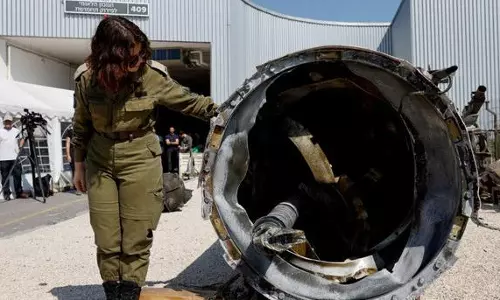
A split to compete on a communal platform
text_fieldsNobody would see any significance in the advance declaration by Shiv Sena, the seniormost ally of the National Democratic Alliance (NDA), that it will contest the coming parliamentary elections alone. In any case it will be viewed as nothing more than a last ditch attempt to assert its existence at a time when the party is withering beside the BJP.
The Shiv Sena national executive council resolution that for the last three years BJP has been trying to destroy it with the backing of power, is an indication of the circumstances that forced Thackeray's party to snap its 29-year long ties with the alliance. At the same time, the Sena's statement that it will not withdraw from the central and state governments, also gives the message that it is not going to sacrifice power as part of the new political policy.
The bickering between the BJP and Shiv Sena is not something new. In the 2014 state elections and in the Mumbai Corporation election last year, both parties had contested separately. In the 288-member state assembly, the BJP bagged 122 seats, when the Sena had to be contented with 63. It was in 1989 when under the leadership of Bal Thackeray the communal and divisive politics was running amuck, that the BJP's strong man in Maharashtra, Pramod Mahajan took the initiative to form a new alliance. In 1995, the state government formed under the leadership of Sena leader Manohar Joshi was doing Thackeray's bidding. When the party faced a split post Bal Thackeray and started moving in two directions, the leadership of the weaker of the two, Udhav Thackery could not help succumbing to the saffron politics that made waves on a national scale. At that stage, the only area where the Sena could hold out was in Mumbai Corporation where it continued to have the reins of power. But as long as the party stands shoulder to shoulder with the BJP which dominates the Maharashtra scene now, the Sena is likely only to see its sway weaken, and by no means to recapture its lost glory. It may be such an assessment that drove the party to make this unexpected exit declaration when a year is left before the next election.
The ‘enthusiasm’ the Sena leaders show in criticizing the Modi government and the BJP leadership at every given opportunity has always been looked at with surprise by the people. It is a well-known fact that neither of these parties does not hesitate to go to any extent in playing the communal card in their attempts to provoke the masses with a motto of bagging more votes. The people are well aware that there is no difference whatsoever between these two parties in terms of their ideology or political approach. It seems that Uddhav Thackeray has realized that his party might lose its grip if it remains as the junior ally of the BJP for long. His latest efforts could be the result of a calculation in that sense and hence he would be trying to regain the ‘legacy’ of Bala Saheb Thackeray. If that is the case, it has been anticipated that Maharashtra and the neighbouring state would soon witness a series of violence unleashed by ultra-communalism. On paper, Shiv Sena is a national party. However, it has not been able to make inroads into the neighbouring Karnataka or Gujarat, let alone to build a proper party system. At the same time, the successors of Bala Saheb are not ready to accept the supremacy of the BJP in Maharashtra.
The Sena is deeply disturbed by the fact that the party is losing its clutches as the saffron politics is witnessing a steady growth in the State by each election. The Sena leadership is forced to adopt a ‘novel’ approach to have its remaining cadres standing with it and also to show that the legacy of Shiv Sena has not faded. What scares the observers is the thought that if the party would go back to the dark era of Bal Thackeray, an era when hooligans were let free to frighten the Mumbai city in the name of ‘sons of the soil’ stir, and to damage cricket pitches by raising anti-Pakistan sentiments.
Shiv Sena with a strength of 18 in the Lok Assembly is the second largest party in NDA behind the BJP. Although the Sena's break with the alliance will not pose any threat to the Modi government, good sense will tell that it does not bode well. The Modi government has a style of behaviour different from that of former NDA prime minister AB Vajpayee, who had held together 24 relatively strong parties and taken care of them with due honour and respect under a common minimum programme. And as such there may not be any immediate attempts to bring the Sena back to the fold. Shetkari Sanghatana, the party known as the farmers' party in Maharashtra, had left NDA in protest against the anti-farmer policies of Modi government. It may be only because of complacence that the Modi-Shah combine - amidst their preoccupation with roping in the top leaders of other parties especially the Congress - does not bother much about such setbacks.























